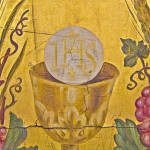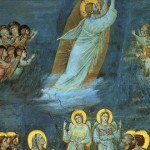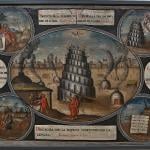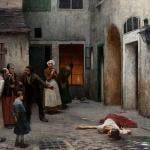
We pretty much have everything back in place here at Cosmos The In Lost. The site still might go through a theme overhaul, but we’re sticking with what we have for right now. There will be a preview of upcoming book reviews tomorrow. Promise.
Today we bring you a guest post from The City and the World on the recent death–there’s something offensively insubstantial about the euphemism “passing”–of Seamus Heaney. We caught the Irish bard in time several weeks ago for our Top 10 living religous poets list with a selection that’s a bit haunting in retrospect (read it here). The list itself will be shortly updated with the work of this and this poet.
The great Irish poet and Nobel laureate Seamus Heaney died today in Dublin at the age of 74. I saw Heaney once, a decade ago, when he gave a reading of some of his poems at the University of Notre Dame. My most vivid memory of that experience is the surprisingly rapturous response that Heaney received from the mostly undergraduate audience; I don’t know whether that group of eighteen- to twenty-two-year-olds contained many who had read Heaney’s poems, or whether more knew him as the translator of the edition of Beowulf that they had been assigned to read in high school, or whether many were simply motivated by Irish pride, but that student audience at Notre Dame gave Heaney an enthusiastic standing ovation before as well as after his reading. Whatever else might be said about Seamus Heaney, I’ll always remember him as the poet who brought the young men and women of Notre Dame to their feet.
Raised a Roman Catholic, Seamus Heaney lost his faith later on but retained a thoughtful appreciation for the religious culture that helped to make him a poet. In an interview with his fellow poet Dennis O’Driscoll, published in the book Stepping Stones: Interviews with Seamus Heaney, Heaney expressed a sort of pensive nostalgia in speaking of his youthful piety and subsequent loss of faith:
. . . Like everyone else, I bowed my head at Mass during the consecration of the bread and wine, lifted my eyes to the raised host and the raised chalice. I believed (whatever it means) that a change occurred; I went to the altar rails and received the mystery on my tongue, returned to my place, shut my eyes fast, made an act of thanksgiving, opened my eyes and felt time starting up again. It was phenomenally refreshing and, when I began to admit to myself that I was losing faith in it, I was very sorry. Intellectually speaking, the loss of faith occurred offstage, there was never a scene where I had it out with myself or another. But the potency of those words [‘transubstantiation’ and ‘real presence’] remains for me, they retain an undying tremor and draw; I cannot disavow them. Nor can I make the act of faith. . . .
In the same interview, Heaney spoke thoughtfully of his experiences as a university student going on pilgrimage to the ancient shrine known as St. Patrick’s Purgatory at Lough Derg in Donegal. As Heaney would candidly admit to O’Driscoll, his motives for making the ascetical pilgrimage were not primarily spiritual:
Curiosity had a lot to do with it. I’d been hearing about Lough Derg since I was a youngster, about people in earlier generations doing ‘the black fast.’ Apparently they would walk the whole way to Donegal, keeping going on black tea and dry bread. So that scenario was with me from the start and, when the time eventually came, I set off in a spirit that Chaucer would have recognized – for the company and the outing, just to see what was entailed. The first time was after the summer exams at Queen’s; we travelled by special bus from the Catholic chaplaincy, in a party that included a fair number of the people I used to knock around with. A couple of years before, we’d all been college boys and convent girls, but now we were beginning to take the measure of ourselves and our freedom, so there was a flirtatious aspect to the trip. But there was a religious dimension too. The fasting and the all-night vigil had the attraction of the unknown. The first couple of times I went were basically end-of-term expeditions, although it’s possible at this stage to see them as a rite of passage. A ‘been there, done that’ sort of thing.
. . .
. . . Lough Derg was a ritual, it entailed the fulfillment of set exercises, the repetition of prayers, keeping a fast, going round the basilica and ‘the beds’ in your bare feet. While you were engaged in all that, you were necessarily concentrated on getting through it but not necessarily absorbed in sacred reverie. Nor were you required to be. Technically speaking, there was a plenary indulgence to be gained by completing the pilgrimage, but the real motivation was in pitting yourself against the conditions – the fasting, your bare feet on hard ground, rain or shine, keeping awake during the first night and the second day. At the end of it all, there was a definite catharsis. As you sailed away from the island, you’d sing the Lough Derg hymn, ‘Hail, glorious Saint Patrick’; but, deep inside, your body and soul were singing, ‘Look, we have come through!’
Seamus Heaney was far from the only person who has set out on a religious pilgrimage with mixed motives, but among such pilgrims he was relatively rare as one who, like Chaucer, found poetic inspiration in the experience. The Lough Derg pilgrimage would inspire one of Heaney’s collections of poetry, Station Island. To round out this post, I would like to share some lines from Canto IV of the title poem in that collection, in which Heaney describes an imagined encounter along the pilgrim trail with a onetime acquaintance from his native place who had gone on to become a Roman Catholic priest:
Blurred swimmings as I faced the sun, my back
to the stone pillar and the iron cross,
ready to say the dream words I renounce . . .
Blurred oval prints of newly ordained faces,
‘Father’ pronounced with a fawning relish,
the sunlit tears of parents being blessed.
I met a young priest, glossy as a blackbird,
as if he had stepped from his anointing
a moment ago; his purple stole and cord
or cincture tied loosely, his polished shoes
unexpectedly secular beneath
a pleated, lace-hemmed alb of linen cloth.
His name had lain undisturbed for years
like an old bicycle wheel in a ditch
ripped at last from under jungling briars,
wet and perished. . . .
At this point, the ghostly young priest tells how he went off to serve as a foreign missionary after his ordination, undergoing a spiritual and physical trial that led him to conclude that “my vocation is a steam off drenched creepers.” Then Heaney intervenes again, with words that cut the priest to the quick and draw an equal sharp reply:
You can read the conclusion to this post right here on Joe’s blog. I highly recommend it.












